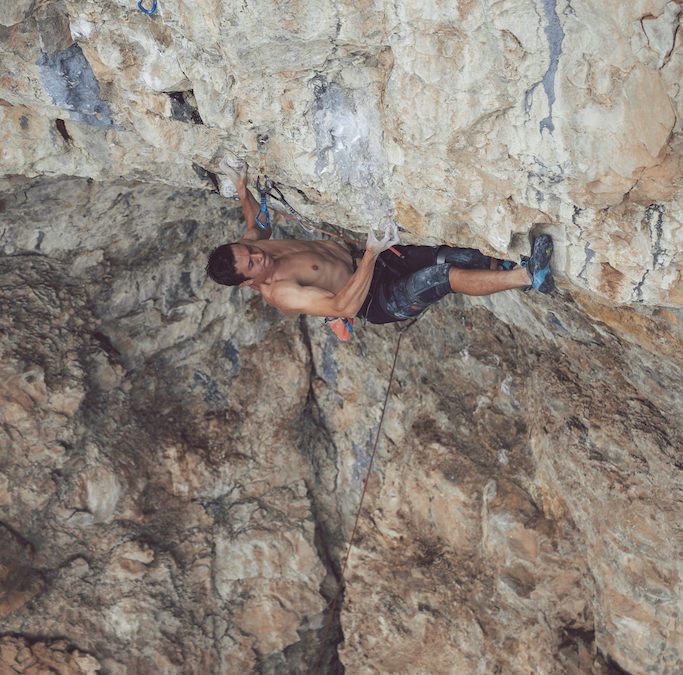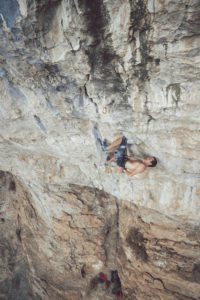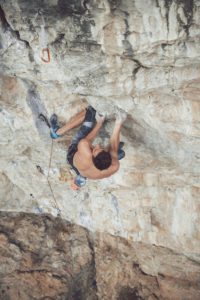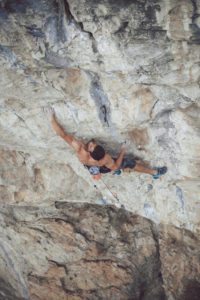Matty Hong Climbs Tommy Caldwell’s Legacy
American Matty Hong talks about climbing one of America's oldest and boldest sport routes in Colorado's Fortress of Solitude.
 Photo by: Margo Hayes
Photo by: Margo Hayes
“It’s a weird thing to try and describe, I don’t really know how I felt.”
New Castle, Colorado sits 30 minutes outside one of America’s most historic climbing destinations. While many might know of Rifle, Colorado, fewer will have heard of the red state’s Fortress of Solitude.

In 2003, American Tommy Caldwell continued his series of difficult first ascents around Colorado. He established a challenging new climb, Flex Luthor, a 5.15a that attained a notorious reputation for fragile rock and difficult sequences. The route would remain unrepeated for 18 years.
Today, only a select number of routes and boulder problems manage to persist unrepeated. The average level of the field has increased beyond the point of impossibility. With an increasing number of climbers able to climb 5.15 in a single trip, even the most challenging sport routes have begun to fall with greater consistency. Despite this fact, Flex Luthor went unsent until a Colorado local took to on the challenge.
30-year-old Matty Hong has sport climbed in Colorado all his life. “It’s kind of how I entered the sport,” he said. He grew up projecting in Rifle before embarking on greater trips around the world. Many of Hong’s hardest first ascents went up in Rifle, despite his fairly international presence. In 2018, Hong climbed Fight or Flight, a Chris Sharma 9b sport route in Oliana Spain. This punchy line held little space for rest, forcing the young American to almost boulder through the challenging 5.15b.

In the subsequent years, Hong’s focus shifted to other styles of climbing. He went on trips to Peru and India to explore and develop new climbing, all while pursuing an interest in photography and filmmaking. Returning to Colorado to isolate for the length of the pandemic. “I ended up building a home wall to train on. That definitely had an effect on my approach to projects.” Staying local, Hong began to rediscover his local areas.
With travelling out of the question, Hong said he looked to old projects and ultimately found himself on Flex Luthor. The steep, 45-minute hike to the Fortress of Solitude gave way to an amphitheatre. On the right side of the cave, Caldwell’s unrepeated route awaited. At first, Hong wasn’t stoked.
“I mean, Flex Luthor I had always heard was choss,” he laughed. “I heard it was dirty, I heard that holds had broken to the point where certain sequences weren’t possible, so Flex was a complete 180-degree flip from my original perception of the route to how I look at it now. It is really a masterpiece.”
He began to siege the route. Waking, Hong and his partner Margo drove three hours from Boulder to give the route attempts. It would take multiple sessions before he felt he had a sequence for the entire climb. Where most modern repeats come complete with beta that can help the climber reach the top, Hong did not even know if the route remained the same as when Caldwell did it. In this way, the route felt different most other repeats.

“The process felt almost like trying a first ascent. I didn’t have any beta for the route, so I spent a lot of time just working out sequences and trying individual moves. It took a long time. It took multiple trips to the cliff before I figured out a sequence that worked. Usually after someone’s climbed a route you have so much more information than you do if you’re the first person to climb something. A route like Flex Luthor, it doesn’t make sense right away. You have to put your body in different positions and really figure it out move by move.”
Hong said that he normally approaches a climb with a pretty clear idea in mind. Normally he can do or imagine doing most of the moves on the first day. With Flex this was not the case. “I had climbed the top half of the route, but there was still this three-bolt section below that I had no idea what to do.”
Adding to the challenge, the Fortress of Solitude has a unique conditions window. Ideally, the climber approaches the route in the fall when conditions are cool but not cold. In autumn, however, the route bakes in the sun until 5:30 pm. The sun then sets at 6:30 pm. “You really get hosed some days. You hike up there, it’s noon, and you wait until it gets in the shade. That can be three or four hours, and then you only have one try. The time restrictions presented a big challenge. Just finding conditions was a hindering aspect of trying the route at the beginning.”
Hong continued that the route was made even more difficult by the fact that he could only try to redpoint, or ascend the route, after a rest day. This meant each redpoint attempt effectively came complete with a collective six hours of driving and over an hour of hiking. In the end, Hong credits Margo for her help.

“I really relied on Margo. She stepped up to the plate and offered to be my partner, to support me up there. Having her be there as a support system is just massive in sport climbing. I think all sport climbers can attest to that. Having a belayer that is committed to your ascent as much as you are can be night and day when you are trying something like this.”
After a year of effort, Hong came close to sending only twice. He climbed through the bottom crux from the ground once last season. He climbed all the way to the last move before ultimately falling. Walking away empty handed and injured, Hong queued up for another season. Maintaining his focus, he pushed into this year’s season falling once again on the final move. Understanding the nature of the process, Hong returned once again.
He pulled through the first 30 feet of 5.13 before entering a precise V12. “The style of the crux is intricate and a little dependent on luck. The way your grab some of the holds has to be perfect. There’s no readjusting based on your body position so if you miss a hold it usually meant you would fall right away.”
Pulling through this section, Hong achieved a bad rest before banging out the last V8 that leads to the half-way point. Hong said the first half alone could go as 15a, and still a tough 14b remained. “It’s a series of boulder problems separated by bad rests. The very end of the route for me was the red point crux. It is just the ultimate endurance test.

“When I climbed from bottom to top it took a little over 20 minutes. A lot of that time you are thinking about that last move. It is stressful,” he laughed. “When I finally did the climb, I was nervous-shaking. Falling on the ending again could have created major mental challenges.”
Striving against the pump and nerves, Hong clipped the chains and concluded his journey to this second ascent. He didn’t know how to feel. Taking a scream for his effort, Hong lowered. “I just needed to let it all out. It was nice to be there with Margo because she has supported me through this whole process and Carlo, who has also been a partner and is still currently trying the route. But then, you know, driving home, it felt like every other time driving home, except this time we stopped for pizza.”
In attaining this ascent, Hong found an even greater understanding of the first ascensionist’s ability. “First off, the fact that Tommy did this is 2003 is an incredible achievement. It speaks to his towering stature in the climbing world and his accomplishments.
“I think he deserves all the shout outs for his original vision to climb up there.” Hong is hopeful he can get Caldwell to come out to take a look at his sequence. “I know for sure that the crux will be different from the way he climbed it. I know that because when I first started climbing the route I was trying it one way and then holds broke off and I had to re-sequence the crux.”
The big news regarding this climb comes from Hong’s upgrade. If the route were in fact 5.15b in 2003, that would have made it the first of that difficulty by five years. Hong admits he thinks the route is harder post-break than when Caldwell climbed the route, “but not much harder.” What this could suggest remains unclear, but in either case, it has revitalized one of America’s hardest sport climbs through an impressive year-long siege.
Thanks to The North Face for facilitating the interview and Margo Hayes for all of the included images.


